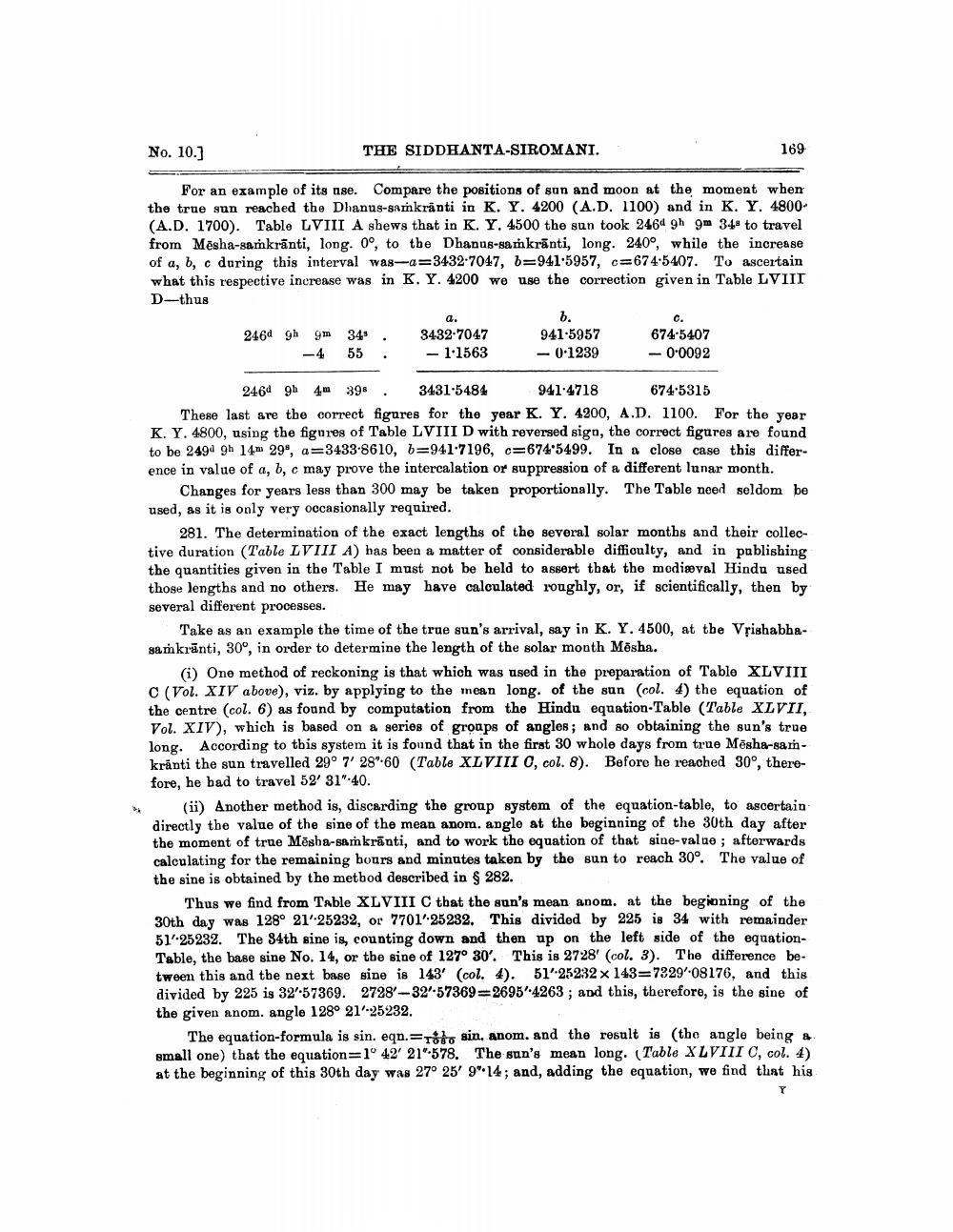________________
No. 10.)
THE SIDDHANTA-SIROMANI.
169
For an example of its use. Compare the positions of sun and moon at the moment when the true sun reached the Dhanus-samkranti in K. Y. 4200 (A.D. 1100) and in K. Y. 4800(A.D. 1700). Table LVIII A shews that in K. Y. 4500 the sun took 2464 gh gm 318 to travel from Mēsha-samkrānti, long. 0°, to the Dhanus-samkrānti, long. 240°, while the increase of a, b, c during this interval was-a=3432-7047, b=941:5957, c=674.5407. To ascertain what this respective increase was in K. Y. 4200 we use the correction given in Table LVIII D-thus
b. 2464 ghgm 345 3432-7047 941:5957 674-5407
-4 55 . - 1.1563 -0.1239 -0.0092
a.
c
2464 9h 4, 39. 3431.5484 941 4718 674:5315 These last are the correct figures for the year K. Y. 4200, A.D. 1100. For the year K. Y. 4800, using the figures of Table LVIII D with reversed sigo, the correct figures are found to be 2491 9h 14m 29", a=3433-8610, b=941-7196, c=674 5499. In a close case this difference in value of a, b, c may prove the intercalation or suppression of a different lunar month.
Changes for years less than 300 may be taken proportionally. The Table need seldom be used, as it is only very occasionally required.
281. The determination of the exact lengths of the several solar months and their collective duration Table LVIII A) has been a matter of considerable difficulty, and in pablishing the quantities given in the Table I must not be held to assert that the modiæval Hindu used those lengths and no others. He may have calculated roughly, or, if scientifically, then by several different processes.
Take as an example the time of the true sun's arrival, say in K. Y. 4500, at tbe Vrishabhasamkrānti, 30°, in order to determine the length of the solar month Mesha.
(1) One method of reckoning is that which was used in the preparation of Table XLVIII C (Vol. XIV above), viz. by applying to the mean long. of the sun (col. 4) the equation of the centre (col. 6) as found by computation from the Hindu equation-Table (Table XLVII, Vol. XIV), which is based on a series of groups of angles; and so obtaining the sun's true long. According to this system it is found that in the first 30 whole days from true Mēsha-sankránti the sun travelled 29° 7' 2860 (Table XLVIII O, col. 8). Before he reached 30°, therefore, he had to travel 52' 31"-40.
(ii) Another method is, discarding the group system of the equation-table, to ascertain directly the value of the sine of the mean anom. angle at the beginning of the 30th day after the moment of true Mēsha-samkrānti, and to work the equation of that sine-valge ; afterwards calculating for the remaining bours and minutes taken by the sun to reach 30°. The value of the sine is obtained by the metbod described in 282.
Thus we find from Table XLVIII C that the sun's mean anom. at the beginning of the 30th day was 128° 21'25232, or 770125232. This divided by 225 is 34 with remainder 51-25232. The 34th sine is, counting down and then up on the left side of the equationTable, the base sine No. 14, or the sine of 127° 30'. This is 2728' (col. 3). The difference between this and the next base sine is 143' (col. 4). 51'25232 x 143=782908176, and this divided by 225 is 32-57369. 2728-32-57369=26954-4263 ; and this, therefore, is the sine of the given anom. angle 128° 21'-25232.
The equation-formula is sin. eqn.= to sin, anom. and the result is the angle being & small one) that the equation=1° 42' 21'-578. The sun's mean long. (Table XLVIII C, col. 4) at the beginning of this 30th day was 27° 25' 9":14; and, adding the equation, we find that his




